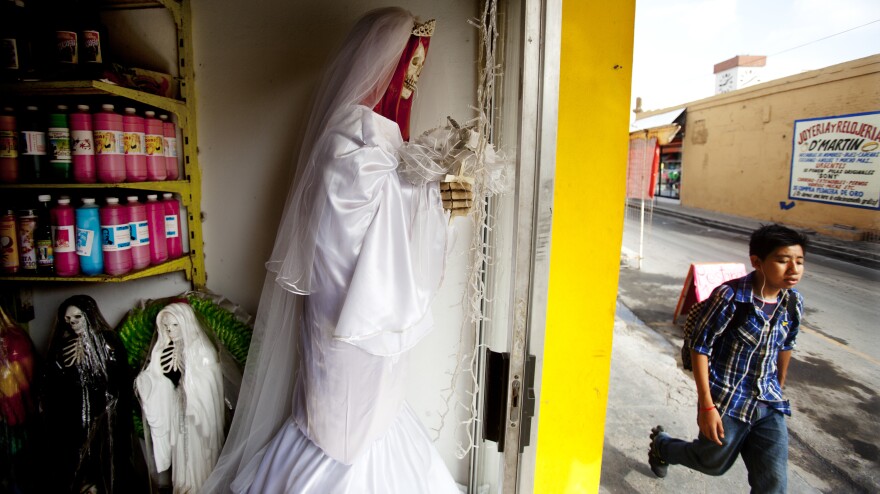The intrepid tourist who visits the market in the border city of Matamoros will find her between the onyx chess sets and Yucateca hammocks. She looks like a statue of the Grim Reaper dressed in a flowing gown. She is Santa Muerte, or Saint Death.
Originally revered as an underground folk saint in Mexico, her popularity has jumped the Rio Grande and spread to Mexican communities throughout the United States.
The statue — holding a scythe in one hand and the world in another — is displayed prominently in Spanish-speaking flea markets and botanicas, religious curio shops in the Southwest.
Devotion to Santa Muerte remains controversial in Mexico because while she is regarded as an all-purpose deity to many working-class Mexicans, she is considered the patron saint of violent drug mafias.
" Santa Muerte is sacred for people who mostly are involved in illicit business, like smuggling drugs and people," says Juarez market shopkeeper Abel Ramirez. "For my part, I'll sell a statue, but I don't believe in her."

A short distance away, a botanica called La Patrona is named in honor of Saint Death. The shelves are filled with votive candles, incense, soap, perfumes and figurines in the image of the Bony Lady, as she's called.
The owner, who gives her name as Senora Tina, has neatly coiffed hair, and a small figure of Saint Death dangles from her neck. She says she has been a follower for 40 years.
"I have lots of clients who've turned away from Saint Jude [the saint of lost causes] and now follow La Santisima," she says. "Maybe they were in a terrible highway accident and they beseeched her to spare their life, and they walked away from the crash. She is the only one who can take a life because she is Saint Death."
Growing Popularity In The U.S.
Senora Tina says the cult of Santa Muerte is growing fast north of the border, where she has many clients who travel to Matamoros for consultations.

"In the U.S., there's lots of debauchery. Men are always changing partners. That's when the woman appeals to Santa Muerte to bring her man back home," she says.
References to Saint Death date back as far as the colonial Spanish period, but her following exploded at the beginning of this century when she began to be identified in the media as the patroness of Mexican drug mafias.
Andrew Chesnut, Bishop Sullivan Chair of Catholic Studies at Virginia Commonwealth University, is the author of Devoted to Death: Santa Muerte, the Skeleton Saint. He has studied her "meteoric" popularity in the past dozen years.
"One of the main reasons for the growth and popularity of Saint Death is that she has a reputation as a speedy and efficacious miracle worker in health, wealth and love," says Chesnut. "Some devotees approach her like a Christian saint. Others use her like an amoral folk saint, and that would be true for the narcos who ask her to protect their shipments of meth from Michoacan to Houston."
Denunciation From The Vatican
Chesnut points out that the bony lady has grown so big in Mexico that a top Vatican official, Cardinal Gianfranco Ravasi, president of the Pontifical Council for Culture, has denounced her mushrooming cult on four separate occasions.
Ravasi called her "sinister and infernal" and said to worship her "is the celebration of devastation and of hell."
Border mayors periodically order the destruction of public shrines to Saint Death that appear on the edges of poor colonias. The latest cleanup campaign is in Matamoros. City Manager Jorge Villareal chooses his words carefully, so as not to offend the murderous Gulf Cartel members in his city who venerate Saint Death.
"In Mexico, anyone can believe in whatever religion they want," he says. "But they have to do so in temples and inside their homes, not in the public roads."
The person who installed the statue of Saint Death in the median of the Beach Highway, which the city hauled to the dump, is a middle-aged woman named Claudia Rosales. She says she's a businesswoman who sells clothing and shoes. She has tattoos of the skeletal deity on her arms and back, and her office houses a large shrine to Santa Muerte featuring statues, fresh flowers and offerings of tequila and apples.
"Well, I think the mayor should not get involved in the beliefs of the people," says Mrs. Rosales. "God sent Saint Death to us as a messenger, as a mediator. She's like our lawyer."
Copyright 2020 NPR. To see more, visit https://www.npr.org. 9(MDA4MzM1MjM1MDEzMTg5NTk0MzNmOTQ5MA004))



